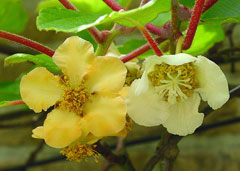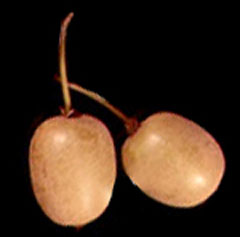 |
|
http://commons.wikimedia.org/wiki/User:Gerhard_Elsner |
 |
|
Translate this page:
Summary
Physical Characteristics

 Actinidia chinensis is a deciduous Climber growing to 7.5 m (24ft 7in).
Actinidia chinensis is a deciduous Climber growing to 7.5 m (24ft 7in).
See above for USDA hardiness. It is hardy to UK zone 7 and is not frost tender. It is in flower from May to June, and the seeds ripen from October to December. The species is dioecious (individual flowers are either male or female, but only one sex is to be found on any one plant so both male and female plants must be grown if seed is required). and is pollinated by Bees, insects. The plant is not self-fertile.
Suitable for: light (sandy), medium (loamy) and heavy (clay) soils. Suitable pH: mildly acid, neutral and basic (mildly alkaline) soils. It can grow in semi-shade (light woodland) or no shade. It prefers moist soil.
UK Hardiness Map
US Hardiness Map
Synonyms
Plant Habitats
Woodland Garden Sunny Edge; Dappled Shade;
Edible Uses
Edible Parts: Fruit Leaves
Edible Uses:
Fruit - raw or cooked. A delicious flavour. The fruit is up to 3cm across[198]. Fresh fruits contain 100 - 420mg vitamin C per 100g and 8 - 14% carbohydrate[218]. Acidity is 1 - 2%, mainly citric acid[218]. The fruit contains a number of small seeds, but these are easily eaten with the fruit[K]. The leaves are eaten cooked in times of need as a famine food[179].
References More on Edible Uses
Medicinal Uses
Plants For A Future can not take any responsibility for any adverse effects from the use of plants. Always seek advice from a professional before using a plant medicinally.
Diuretic Febrifuge Sedative Urinary Vitamin C
The fruits, stems and roots are diuretic, febrifuge and sedative[147]. They are used in the treatment of stones in the urinary tract, rheumatoid arthralgia, cancers of the liver and oesophagus[147]. A decoction of the leaves is used to treat mange in dogs[218]. The stem-juice is used in the treatment of gravel[218].
References More on Medicinal Uses
The Bookshop: Edible Plant Books
Our Latest books on Perennial Plants For Food Forests and Permaculture Gardens in paperback or digital formats.

Edible Tropical Plants
Food Forest Plants for Hotter Conditions: 250+ Plants For Tropical Food Forests & Permaculture Gardens.
More

Edible Temperate Plants
Plants for Your Food Forest: 500 Plants for Temperate Food Forests & Permaculture Gardens.
More

More Books
PFAF have eight books available in paperback and digital formats. Browse the shop for more information.
Shop Now
Other Uses
Insecticide Paper Pencil
Paper is made from the bark[178]. If the bark is removed in one piece from near the root and placed in hot ashes, it becomes very hard and can be used as a tube for a pencil[178]. The plant is said to have insecticidal properties (no more details)[218].
Special Uses
Food Forest Scented Plants
References More on Other Uses
Cultivation details
Prefers a sound loamy neutral soil[1, 200]. Succeeds in semi-shade but full sun is best for fruit production[200]. Prefers a sheltered position[200]. The dormant plant is hardy to about -15°c[184], though new growth in spring is very susceptible to frost damage[11]. This species is the parent of the cultivated Kiwi fruits, these cultivars are now included under the name A. deliciosa[200]. Fruits are formed on second year wood and also on fruit spurs on older wood[126], any pruning is best carried out in the winter[219]. The flowers are sweetly scented[245]. This is a climbing plant, supporting itself by twining around branches etc[200]. The ssp. A. chinensis setosa.(newly named, no author as yet) is found in Taiwan from 1300 - 2600m[198]. Plants in this genus are notably resistant to honey fungus[200]. Dioecious. Male and female plants must be grown if seed is required.
References Carbon Farming Information and Carbon Sequestration Information
Temperature Converter
Type a value in the Celsius field to convert the value to Fahrenheit:
Fahrenheit:
The PFAF Bookshop
Plants For A Future have a number of books available in paperback and digital form. Book titles include Edible Plants, Edible Perennials, Edible Trees,Edible Shrubs, Woodland Gardening, and Temperate Food Forest Plants. Our new book is Food Forest Plants For Hotter Conditions (Tropical and Sub-Tropical).
Shop Now
Plant Propagation
Seed - sow spring in a greenhouse[133]. It is probably best if the seed is given 3 months stratification[113], either sow it in a cold frame as soon as it is ripe in November or as soon as it is received. Fresh seed germinates in 2 - 3 months at 10°c, stored seed can take longer[133]. When they are large enough to handle, prick the seedlings out into individual pots and grow them on in light shade in the greenhouse for at least their first winter. When the plants are 30cm or more tall, plant them out into their permanent positions in late spring or early summer, after the last expected frosts[K]. Most seedlings are male[126]. The seedlings are subject to damping off, they must be kept well ventilated[113]. Cuttings of softwood as soon as ready in spring in a frame[K]. Cuttings of half-ripe wood, July/August in a frame. Very high percentage[113]. Cuttings of ripe wood, October/November in a frame.
Other Names
If available other names are mentioned here
Chinese gooseberry, Ichang gooseberry, Yangtao, Yemihoutao [1-4].
Native Range
TEMPERATE ASIA: China (Anhui Sheng, Zhejiang Sheng, Fujian Sheng, Henan Sheng, Hunan Sheng, Hubei Sheng, Jiangxi Sheng, Jiangsu Sheng, Guangdong Sheng (north), Shaanxi Sheng (south), Yunnan Sheng, Guangxi Zhuangzu Zizhiqu (north)), Taiwan
Weed Potential
Right plant wrong place. We are currently updating this section.
Please note that a plant may be invasive in one area but may not in your area so it's worth checking.
Conservation Status
IUCN Red List of Threatened Plants Status :

Growth: S = slow M = medium F = fast. Soil: L = light (sandy) M = medium H = heavy (clay). pH: A = acid N = neutral B = basic (alkaline). Shade: F = full shade S = semi-shade N = no shade. Moisture: D = dry M = Moist We = wet Wa = water.
Now available:
Food Forest Plants for Mediterranean Conditions
350+ Perennial Plants For Mediterranean and Drier Food Forests and Permaculture Gardens.
[Paperback and eBook]
This is the third in Plants For A Future's series of plant guides for food forests tailored to
specific climate zones. Following volumes on temperate and tropical ecosystems, this book focuses
on species suited to Mediterranean conditions—regions with hot, dry summers and cool, wet winters,
often facing the added challenge of climate change.
Read More
Expert comment
Author
Planch.
Botanical References
198200266
Links / References
For a list of references used on this page please go here
Readers comment
| Add a comment |
|
If you have important information about this plant that may help other users please add a comment or link below. Only comments or links that are felt to be directly relevant to a plant will be included. If you think a comment/link or information contained on this page is inaccurate or misleading we would welcome your feedback at [email protected]. If you have questions about a plant please use the Forum on this website as we do not have the resources to answer questions ourselves.
* Please note: the comments by website users are not necessarily those held by PFAF and may give misleading or inaccurate information.
To leave a comment please Register or login here All comments need to be approved so will not appear immediately.
|
Subject : Actinidia chinensis
|
|
|
|